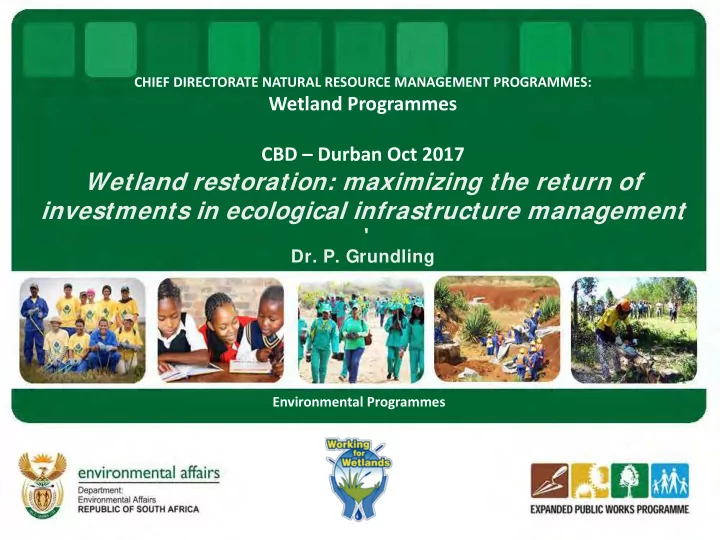

CHIEF DIRECTORATE NATURAL RESOURCE MANAGEMENT PROGRAMMES: Wetland Programmes CBD – Durban Oct 2017 Wetland restoration: maximizing the return of investments in ecological infrastructure management ‘ Dr. P. Grundling Environmental Programmes
The role of wetlands: a moment to recap …… It is well documented that wetlands are: • One of the 5 live support ecosystems of planet earth • It provides various goods and services free of charge to society including amongst other: However, wetlands are also the most threatened ecosystem on earth.
The role of wetlands: some questions we need to ask • Is wetland conservation an investment in ecological infrastructure that is contributing to Biodiversity Economy? • Does wetland restoration enhance ecosystem resilience which ensure benefits to society?
International Perspective: Wetland loss • Wetlands cover 4 – 6 % of earth’s land surface. • Host more then 10 % of fresh water and 30% of terrestrial carbon . • the Millennium Ecosystem Assessment (2005) reported that more than 50 % of the area of certain wetland types had been lost during the 20th century. • Junk et al. (2013), the amount of loss of wetlands around the world varies between 30 and 90 %, depending on the region. • Review of Davidson (2014)found that the extent of inland wetlands declined 69-75 % during the 20th century. • SA: 20 - 58% lost: 48% of remainder threatened
African Perspective: • Wetlands link us together: – From Ethiopia to southern Africa – Whitewing flufftail: only 250 pairs – Occurs only in the wetlands of Ethiopia and (to??) southern Africa
Therefore…… The purpose of Working for Wetlands • In the past was to champion the protection, rehabilitation and sustainable use of South Africa’s wetlands through co -operative governance and partnerships • Main drive in the past 17 years was wetland restoration • Question: How do we ensure we maximise the return of investments (U$100 mil) in ecological infrastructure management of wetlands? • KEY COMPONENT: Planning back-up by research and science:
Understand what you work with…..
How wetlands function in a “nutshell” (Kotze et al., 2005) Found where surface water is slowed down and spread out (slope is usually gentle) Deposition of sediment Prolonged saturation of the soil Anaerobic High plant productivity Inhibited decomposition leading to high soil organic matter content Favourable environment for a wide range of chemical transformations
How wetland restoration should happen in a nutshell Wetlands result from several driving forces, including geomorphological setting, hydrology, physical and biological processes Scientific based understanding Wetland rehabilitation aims to achieve a persistent resilient system that is largely self-maintaining and can respond to change with little human intervention Monitoring and Evaluation Adaptive managment Wetland functioning and management are complex, and without effective planning, the effective management, monitoring and rehabilitation of wetlands are unlikely to be cost-effective
Therefore… the WfWet way:
Working for Wetlands Planning requirements: Wetlands depend on catchments • Prioritise catchments • Prioritise wetlands for rehabilitation per catchment with provincial wetland forums • Identify and quantify impacts per wetland • Compile wetland assessment and rehabilitation plan • In parallel: Socio-economic aspects
Planning Monitoring & Evaluation Feedback into • Planning and • Maintenance
Outcomes-based prioritization framework Biodiversity maintenance: Functional enhancement: What opportunity exists to contribute What opportunity exists to contribute towards biodiversity conservation towards the enhancement of wetland objectives. functioning. Catchment priority : Catchments that provide the greatest opportunity from either a biodiversity maintenance or functional enhancement perspective.
National Prioritization
Practical principles • What is happening in the catchment? • What is happening in the rest of the w etland? • What might happen in future?
Practical examples 1. Deactivate erosion: Kromme Wetland: Soft option chutes Photo’s: Japie Buckle
From Space: Kromme 2003 vs 2016
Practical examples 2. Deactivate erosion and rewetting: Palmiet Wetland – Hard options: Concrete gabion weir
From Space: Duivenhoks Palmiet Wetland 2009 vs 2016
Practical examples 3. Erosion control, rewetting, flood mitigation, baseflow maintenance: Memel Wetland Ramsar site – Hard options: Concrete weir
From Space: Memel Ramsar Wetland in 2011(9 years later)
Practical examples 4. Erosion control, rewetting, flood mitigation, baseflow maintenance: Zoar Wetland – Soft options: Earth Structures
From Space: Zoar Wetland in 2011 (11 years later)
Experience in the past 5 years has revealed some problems with implementation, resulting in the failure of restoration measures: • Failing structures • Use of inferior materials • Wrong application of materials and measures • Lack of capacity to build according to design • BUT: IS THE DESIGN BASED ON WHAT WE HAVE PLANNED?
Thanks for the opportunity Merci pour cette opportunité
Recommend
More recommend